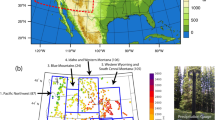Abstract.
The performance of a snow cover model in capturing the ablation on the Greenland ice sheet is evaluated. This model allows an explicit calculation of the formation of melt water, of the fraction of melt water which re-freezes, and of runoff in the ablation region. The input climate variables to the snowpack model come from two climate models. While the higher resolution general circulation model (ECHAM 4), is closest to observations in its estimate of accumulation, it fails to give accurate results in its predictions of runoff, primarily in the southern half of the ice sheet. The two-dimensional low-resolution climate model (MIT 2D LO) produces estimates of runoff from the Greenland ice sheet within the range of uncertainty of the Inter governmental Panel on Climate Change (IPCC1) 1995 estimates. Both models reproduce some of the characteristics of the extent of the wet snow zone observed with satellite remote sensing; the MIT model is closer to observations in terms of areal extent and intensity of the melting in the southern half of the ice-sheet in July and August while the ECHAM model reproduces melting in the northern half of the ice sheet well. Changes in runoff from Greenland and Antarctica are often cited as one of the major concerns linked to anthropogenic changes in climate. Because it is based on physical principles and relies on the surface energy balance as input, the snow cover model can respond to the current climatic forcing as well as to future changes in climate on the century time scale without the limitations inherent in empirical parametrizations. For a reference climate scenario similar to the IPCC's IS92a, the model projects that the Greenland ice sheet does not contribute significantly to changes in the level of the ocean over the twenty-first century. Increases in accumulation over the central portion of the ice sheet offset most of the increase in melting and runoff, which takes place along the margins of the ice sheet. The range of uncertainty in the predictions of sea-level rise is estimated by repeating the calculation with the MIT model for seven climate change scenarios. The range is –0.5 to 1.7 cm.
Similar content being viewed by others
Author information
Authors and Affiliations
Additional information
Electronic Publication
Rights and permissions
About this article
Cite this article
Bugnion, .V., Stone, .P. Snowpack model estimates of the mass balance of the Greenland ice sheet and its changes over the twentyfirst century. Climate Dynamics 20, 87–106 (2002). https://doi.org/10.1007/s00382-002-0240-1
Received:
Accepted:
Issue Date:
DOI: https://doi.org/10.1007/s00382-002-0240-1




